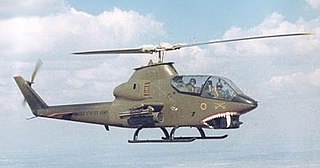
The Bell AH-1 Cobra is a single-engined attack helicopter developed and manufactured by the American rotorcraft manufacturer Bell Helicopter. A member of the prolific Huey family, the AH-1 is also referred to as the HueyCobra or Snake.

The Hughes OH-6 Cayuse is a single-engine light helicopter designed and produced by the American aerospace company Hughes Helicopters. Its formal name is derived from the Cayuse people, while its "Loach" nickname comes from the acronym for the Light Observation Helicopter (LOH) program under which it was procured.
Piasecki Helicopter Corporation designed and manufactured helicopters in Philadelphia and nearby Morton, Pennsylvania, in the late 1940s and the 1950s. Its founder, Frank Piasecki, was ousted in 1956 and started a new company, Piasecki Aircraft. Piasecki Helicopter was renamed Vertol Corporation in early 1956. Vertol was acquired by Boeing in 1960 and renamed Boeing Vertol.

The Piasecki H-21 Workhorse/Shawnee is an American helicopter, the fourth of a line of tandem rotor helicopters designed and built by Piasecki Helicopter. Commonly called "the flying banana", it was a multi-mission helicopter, using wheels, skis and floats.

A tandem-rotor aircraft is an aircraft with two large helicopter rotor assemblies mounted one in front of the other in the horizontal plane.

Frank Nicolas Piasecki was an American engineer and helicopter aviation pioneer. Piasecki pioneered tandem rotor helicopter designs and created the compound helicopter concept of vectored thrust using a ducted propeller.

The Sikorsky R-4 is a two-seat helicopter that was designed by Igor Sikorsky with a single, three-bladed main rotor and powered by a radial engine. The R-4 was the world's first large-scale mass-produced helicopter and the first helicopter used by the United States Army Air Forces, the United States Navy, the United States Coast Guard and the United Kingdom's Royal Air Force and Royal Navy. In U.S. Navy and U.S. Coast Guard service, the helicopter was known as the Sikorsky HNS-1. In British service it was known as the Hoverfly.

A tip jet is a jet nozzle at the tip of some helicopter rotor blades, used to spin the rotor, much like a Catherine wheel firework. Tip jets replace the normal shaft drive and have the advantage of placing no torque on the airframe, thus not requiring the presence of a tail rotor. Some simple monocopters are composed of nothing but a single blade with a tip rocket.

A gyrodyne is a type of VTOL aircraft with a helicopter rotor-like system that is driven by its engine for takeoff and landing only, and includes one or more conventional propeller or jet engines to provide forward thrust during cruising flight. During forward flight the rotor is unpowered and free-spinning, like an autogyro, and lift is provided by a combination of the rotor and conventional wings. The gyrodyne is one of a number of similar concepts which attempt to combine helicopter-like low-speed performance with conventional fixed-wing high-speeds, including tiltrotors and tiltwings.

Dragoljub Kosta Jovanovich, also known under his pen name D. K. or "Gish" Jovanovich, was a Serbian-American helicopter designer, inventor, and pioneer in autogyro technology. Born in the Kingdom of Yugoslavia, he subsequently moved to the United States, living first in Philadelphia and later in southern California.

The Platt-LePage XR-1, also known by the company designation PL-3, was an early American transverse rotors helicopter, built by the Platt-LePage Aircraft Company of Eddystone, Pennsylvania. The winner of a United States Army Air Corps design competition held in early 1940, the XR-1 was the first helicopter tested by the USAAF, flying in 1941. The flight testing of the XR-1 proved troublesome, and although continued testing showed that the design had promise, other, improved helicopters were becoming available before the XR-1 was ready for service. As a result, the development of the aircraft was terminated in 1945.

The McDonnell XV-1 is an experimental Convertiplane developed by McDonnell Aircraft for a joint research program between the United States Air Force and the United States Army to explore technologies to develop an aircraft that could take off and land like a helicopter but fly at faster airspeeds, similar to a conventional airplane. The XV-1 would reach a speed of 200 mph, faster than any previous rotorcraft, but the program was terminated due to the tip-jet noise and complexity of the technology which gave only a modest gain in performance.

The McDonnell XHJH Whirlaway, aka McDonnell Model 65, was a 1940s American experimental transverse-rotor helicopter designed and built by McDonnell Aircraft Corporation for the United States Navy and was the largest helicopter at the time, as well as the first successful twin-engined twin-rotor helicopter in the world.

The Sikorsky R-6 is an American light two-seat helicopter of the 1940s. In Royal Air Force and Royal Navy service, it was named the Hoverfly II.
Donovan Reese Berlin was an American military aircraft designer and aircraft industry executive. Among the many designs with which he is associated, are the Curtiss P-36 Hawk, Curtiss P-40 Warhawk and Fisher P-75 Eagle. His name is "synonymous with the development of military aviation". He designed aircraft that were safe, rugged and "a pilot's joy."

Helicopter Air Transport Incorporated (HAT) was formed in New Jersey, United States, to exploit the helicopters which were developed during World War II. It was the world's first commercial helicopter operator.
















